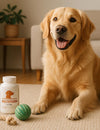
Healthy Dog Treats
Just like we do, dogs love food treats. And just like us, dogs sometimes get too many calories from their treats.
“If you’re not careful, treats can add a substantial amount of calories to your dog’s otherwise normal, healthy diet,” says Tami Pierce, DVM, clinical veterinarian at the University of California, Davis.
You may not actually realize just how many treats your dog gets daily.
“People will give their dog two, three and four treats at a time and not really think about it until they’re asked details about the dog’s health history and diet,” Pierce says.

The 10% Rule
Treats and snacks should only make up 10% of a dog’s daily calories. To get an idea of how many treats that is, ask your vet. They can make a recommendation based on the treats your dog likes, his weight, and how active he is.
But dogs love treats. And people love giving their dog treats. It's a way to bond with your pet, and that's a good thing.
You can still give your dog treats. Just give them one at a time.
Try Veggies and Fruit
You can skip the store-bought snacks that are high in fat, sugar and often preservatives, and try offering your dog some vegetables.
“Give them a baby carrot, a green bean, some broccoli,” Pierce says. “Those have virtually no calories, and dogs don’t care if you’re not giving them something meaty and fatty. They just want you to give them something.”
Dogs are open to all foods, potentially. So vegetables can be a great snack option for your dog.
Try fruits, too. Banana slices, berries, watermelon and apple slices, (with no seeds, of course). Steer clear of grapes, raisins, onions, chocolate and anything with caffeine. These can be toxic to dogs.
Other snacks that can work well as low-calorie dog treats are air-popped popcorn with no salt or butter, and plain rice cakes broken into little pieces.
What to Avoid
Your dog's treats should be easy on their teeth. Skip anything that's hard, like bones, antlers, or hooves.
“So many of the new dog treats like that on the market are fracturing teeth,” Pierce says.
Use the rule of thumb: If you push your thumbnail into a treat and it leaves a mark, that’s a safe treat. If it doesn’t, the treat is too hard for a dog to safely chew.
Rawhide is the exception because as a dog chews on it, it becomes soft. But always watch your dog when she’s gnawing on rawhide, as it can break into little pieces and get lodged in her throat. Best to take it away when it starts getting small, Pierce says.
Want to know if a treat is healthy for your dog’s teeth? Look for the Veterinary Oral Health Council’s seal of approval on it that reads “VOHC Accepted.” If it’s not there, don’t offer it.
Make the dog treats healthy
You can also consider combining treats with pet health supplements. There are many products on the market in the form or chews, pills or oil that have delicious taste and can be used as a daily reward for your friend at the same time delivering many health benefits.There are products on the market that are also low calorie so you can easily introduce them to the daily diet without worrying too much about your friend’s weight.
References
https://pets.webmd.com/dogs/guide/healthy-dog-treats#1





